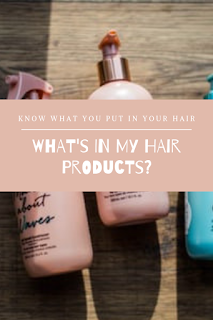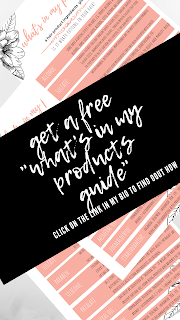Do you know your hair products? Do
you read your ingredients before purchasing your products? What are you even
looking for in the ingredients? If you don’t have an answer to even just
one of these questions, read on. This is worth your time.
Taking
care of your hair is not only important for its growth but it is also a good habit
to adopt.
Knowing
your products is an essential part of taking care of your hair. Know which
products to use to get specific results. It’s easier to work with your hair if
you know what supplements it needs and what products to use.
Don't have time to read this now? save it for later, on pinterest:
Inevitably,
the ingredients are just as important. Ingredients make up the product, so it
is logical to know what is put in the products before purchasing.
You’ll be
shocked to know that some products might seem like what you need but contain a
lot of ingredients that will harm not only your hair but also your health.
For
these reasons, reading your ingredients is important.
On the
flip side, some products are considered horrid because of the misinformation
that goes around. We will clear up some of those later.
Here’s a general overview of what to look for in hair products;
When
looking for moisturizing products, you will mostly have to look for water-based
products which means that the first (sometimes second) ingredient is water or
(aqua).
Because we know the first commandment of natural hair, water is the only
moisturizer!
… no
that’s not a thing. But water is an important moisturizer.
If you
are looking for a sealant however, the story flips. They must not be
water-based since their job is to seal in the moisture that is already put in.
This includes your butter and oils- well oil is not water-based, hence why it
is a very good sealant.
Products
like conditioners and shampoos are preached to be sulfate-free.
Because sulfate
is a detergent and is a bit too good at cleaning, it strips off all the natural
oil from hair.
You know that our hair is already naturally dry. It is
best to stay away from sulfates.
Products
like gel, well you know the jingle, alcohol-free.
However, below is a detailed
look into the ingredients and why they should be avoided, and you might find
that not all of them should be necessarily avoided.
Ultimately,
you make the decision, I’m here to help you make an informed one.
I also
made a handy free printable guide for when you want to remember these products.
Find it at the bottom.
here is a detailed look into some ingredients and their effect on your hair:
1.
Alcohol
Alcohols
are known to have drying effects on hair, and while that is true, not ALL alcohols
have that drying effect.
There
are different kinds of alcohols with different properties. Some alcohols such
as ethanol and SD alcohol can have a drying effect while some such as lauryl
alcohol and cetyl alcohol can be very healthy to your hair.
The
latter has properties like fatty acids and are emulsifying alcohol which is why
they are good for hair.
The
former is short very short carbon-chained alcohols that evaporate quickly. They
are used in hair and skincare products as an additive to help decrease the time
it takes for products to dry once they are applied. These alcohols strip
moisture from hair as a result. They leave hair dry, brittle and frizzy.
How can they be identified?
Some of
the most common drying alcohols you’ll find on your products are ethanol, SD
alcohol, SD 40 alcohol, denatured alcohol, propanol, propyl alcohol, and
isopropyl alcohol.
Alcohols
that are actually good for your hair are; lauryl alcohol, cetyl alcohol,
myristyl alcohol, stearyl alcohol, and behenyl alcohol
2. Sulfates
Sulfates
are chemicals used as cleaning agents. They are found in household cleaners,
detergents, and even shampoos.
They
are used to create a lathering effect (they cause foaming) to remove oil and
dirt.
Sulfates
are too good cleaners that they tend to strip hair of all its natural oils
leaving it dry and brittle.
How can they be identified?
some
most common sulfates include Sodium Lauryl Sulfate (SLS), Sodium Laureth
Sulfate (SLES), Ammonium Lauryl Sulfate, Sodium Myreth Sulfate.
3. Silicone
Silicones
work by covering hair with a waterproof coating to reduce hair porosity. They
are good for straightened hair because they do not allow hair to absorb
humidity.
They
are not too bad to use however, in the long run, they can cause more bad than
good. They are generally loathed for coating the hair and causing build-up.
Silicone
Build-up can cause your hair to resist products making it close to impossible
to moisturize or style or… do pretty anything to it.
How can they be identified?
Some
common silicones are Cyclomethicone, Dimethicone copolyol, Dimethicone or
silicone oil, Amodimethicone
4. Parabens
Parabens
are very efficient and cost-effective preservatives. Because of this, they are
not only found in hair products but also in a wide variety of cosmetics, foods,
beverages, pharmaceuticals and other personal care products.
Paraben
exposure occurs when they are absorbed through the skin into the bloodstream.
They have been found in breast cancer cells and so has been thought to cause
cancer.
No
research has been able to link parabens directly to cancer so far. We are only exposed
to a small percentage.
How can they be identified?
Some
most common parabens are methylparaben, butylparaben, propylparaben.
5. Phthalate
Phthalates are
any salt or esters of phthalic acid. They have a vast spectrum of application.
In hair products, for example, phthalates are used as plasticizers in
hairsprays to help avoid stiffness by allowing them to form a
flexible film on the hair.
Phthalates
are classified as endocrine disruptors which means they can interfere with
hormonal systems at a certain dosage.
Phthalates
like butyl benzyl phthalate are reported to cause eczema and rhinitis to
children. They have been associated with liver, kidneys, lungs and reproductive
organs damage.
How can they be identified?
Some
most common phthalates are di-2-ethyl hexyl phthalate (DEHP), diisodecyl
phthalate (DIDP), butyl benzyl phthalate (BBP), dibutyl phthalate (DBP),
diisononyl phthalate (DINP), and diethyl phthalate (DEP), Dimethyl phthalates.
Again, here, you identify the suffix “-phthalate”
6. Formaldehyde
Many
products may contain formaldehyde-releasing ingredients, which act as a
preservative to kill microorganisms and prevent the growth of bacteria and
other pathogens, extending product shelf life.
Contrary
to popular belief, some studies show that formaldehyde does not accumulate in
people because it is quickly broken down by the body’s natural metabolic
processes.
How can
they be identified?
Some
formaldehyde-releasing ingredients include:
Benzylhemiformal,
2-Bromo-2-nitropropane-1,3-diol, 5-Bromo-5-nitro-1,3-dioxane, Diazolidinyl
urea;1,3-dimethylol-5,5-dimethyl hydantoin (or DMDM hydantoin),Quaternium-15.
7. Ethanolamines {DEA(diethanolamine), MEA(mon) and TEA(tri)}
Ethanolamines
are clear, colour-less, viscous liquids with ammonia-like odours, which have
the combined properties of alcohols and amines.
They
are mostly found in products that foam. This includes foam baths, body washes,
shampoos, soaps, and facial cleansers. They're also found in many other
cosmetic products such as eyeliners, mascara, eye shadows, blush, etc.
They
are thought to be cause chemical burns and inflammation. Prolonged exposure can
result in liver, kidney or nervous system injury.
How can they be identified?
Cocamide
DEA, Cocamide MEA,DEA-Cetyl Phosphate, Lauramide DEA, Linoleamide MEA,
Myristamide DEA, Oleamide DEA, Stearamide MEA, TEA-Lauryl Sulfate
8. Mineral oil
Mineral
oil is a mixture of aliphatic and alicyclic hydrocarbons derived from petroleum.
It
weighs the hair down and prevents natural oils from being produced and absorbed
in the hair.
Petrolatum is
a grease with the same properties as mineral oil and should be avoided.
These
products can easily be identified as “mineral oil” and “petrolatum” in the
ingredients list
This
has been a LONG article, but it was all worth it. Don’t worry about how you
are going to remember all of these because I've prepared a handy printable for you to download absolutely FREE.




This is such helpful information!!! Thank you for putting this together!
ReplyDeleteIt's always so important to read the ingredients list. I don't buy anything without looking at the ingredients first - food & personal care products! I'm so picky & selective because it's scary what is allowed in our products!
ReplyDelete-madi xo | http://www.everydaywithmadirae.com
Thanks for sharing this. I only recently started paying attention to the ingredients I'm putting in my hair after reading an article about the dangers of certain chemicals. Particularly hair dye. I try not to dye my hair too frequently but I can't control my greys, lol. :)
ReplyDeleteVery informative post for sure!
Cori
Nice blog.Thanks for sharing your experience about hair products. But it is still confusing to consider what is best for your hair.
ReplyDeleteIn today's world, where the focus on natural and sustainable living is gaining momentum, more and more people are seeking healthier alternatives for their hair care routines. Natural hair products have emerged as a popular choice, offering numerous benefits without the use of harsh chemicals.
Choosing natural hair products not only benefits your hair but also contributes to a more sustainable future.